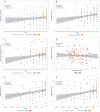Embracing heterogeneity: coalescing the Tree of Life and the future of phylogenomics
- PMID: 30783571
- PMCID: PMC6378093
- DOI: 10.7717/peerj.6399
Embracing heterogeneity: coalescing the Tree of Life and the future of phylogenomics
Abstract
Building the Tree of Life (ToL) is a major challenge of modern biology, requiring advances in cyberinfrastructure, data collection, theory, and more. Here, we argue that phylogenomics stands to benefit by embracing the many heterogeneous genomic signals emerging from the first decade of large-scale phylogenetic analysis spawned by high-throughput sequencing (HTS). Such signals include those most commonly encountered in phylogenomic datasets, such as incomplete lineage sorting, but also those reticulate processes emerging with greater frequency, such as recombination and introgression. Here we focus specifically on how phylogenetic methods can accommodate the heterogeneity incurred by such population genetic processes; we do not discuss phylogenetic methods that ignore such processes, such as concatenation or supermatrix approaches or supertrees. We suggest that methods of data acquisition and the types of markers used in phylogenomics will remain restricted until a posteriori methods of marker choice are made possible with routine whole-genome sequencing of taxa of interest. We discuss limitations and potential extensions of a model supporting innovation in phylogenomics today, the multispecies coalescent model (MSC). Macroevolutionary models that use phylogenies, such as character mapping, often ignore the heterogeneity on which building phylogenies increasingly rely and suggest that assimilating such heterogeneity is an important goal moving forward. Finally, we argue that an integrative cyberinfrastructure linking all steps of the process of building the ToL, from specimen acquisition in the field to publication and tracking of phylogenomic data, as well as a culture that values contributors at each step, are essential for progress.
Keywords: Gene flow; Genome; Multispecies coalescent model; Retroelement; Speciation; Transcriptome.
Conflict of interest statement
Alexander Schliep and Scott V. Edwards are Academic Editors for PeerJ.
Figures







Similar articles
-
Modern Phylogenomics: Building Phylogenetic Trees Using the Multispecies Coalescent Model.Methods Mol Biol. 2019;1910:211-239. doi: 10.1007/978-1-4939-9074-0_7. Methods Mol Biol. 2019. PMID: 31278666
-
Implementing and testing the multispecies coalescent model: A valuable paradigm for phylogenomics.Mol Phylogenet Evol. 2016 Jan;94(Pt A):447-62. doi: 10.1016/j.ympev.2015.10.027. Epub 2015 Oct 27. Mol Phylogenet Evol. 2016. PMID: 26518740 Review.
-
Interspecific gene flow obscures phylogenetic relationships in an important insect pest species complex.Mol Phylogenet Evol. 2023 Nov;188:107892. doi: 10.1016/j.ympev.2023.107892. Epub 2023 Jul 29. Mol Phylogenet Evol. 2023. PMID: 37524217
-
Resolving conflict in eutherian mammal phylogeny using phylogenomics and the multispecies coalescent model.Proc Natl Acad Sci U S A. 2012 Sep 11;109(37):14942-7. doi: 10.1073/pnas.1211733109. Epub 2012 Aug 28. Proc Natl Acad Sci U S A. 2012. PMID: 22930817 Free PMC article.
-
Phylogenomic approaches to detecting and characterizing introgression.Genetics. 2022 Feb 4;220(2):iyab173. doi: 10.1093/genetics/iyab173. Genetics. 2022. PMID: 34788444 Free PMC article. Review.
Cited by
-
PhyloWGA: chromosome-aware phylogenetic interrogation of whole genome alignments.Bioinformatics. 2021 Jul 27;37(13):1923-1925. doi: 10.1093/bioinformatics/btaa884. Bioinformatics. 2021. PMID: 33051672 Free PMC article.
-
Phylogenomics reveals the slow-burning fuse of diatom evolution.Proc Natl Acad Sci U S A. 2025 Jun 3;122(22):e2500153122. doi: 10.1073/pnas.2500153122. Epub 2025 May 29. Proc Natl Acad Sci U S A. 2025. PMID: 40440071
-
Complexity of avian evolution revealed by family-level genomes.Nature. 2024 May;629(8013):851-860. doi: 10.1038/s41586-024-07323-1. Epub 2024 Apr 1. Nature. 2024. PMID: 38560995 Free PMC article.
-
Detecting destabilizing species in the phylogenetic backbone of Potentilla (Rosaceae) using low-copy nuclear markers.AoB Plants. 2020 May 9;12(3):plaa017. doi: 10.1093/aobpla/plaa017. eCollection 2020 Jun. AoB Plants. 2020. PMID: 32547721 Free PMC article.
-
Mining for a New Class of Fungal Natural Products: The Evolution, Diversity, and Distribution of Isocyanide Synthase Biosynthetic Gene Clusters.bioRxiv [Preprint]. 2023 Apr 18:2023.04.17.537281. doi: 10.1101/2023.04.17.537281. bioRxiv. 2023. Update in: Nucleic Acids Res. 2023 Aug 11;51(14):7220-7235. doi: 10.1093/nar/gkad573. PMID: 37131656 Free PMC article. Updated. Preprint.
References
-
- Adamczak R, Miloś P. U-statistics of Ornstein-Uhlenbeck branching particle system. Journal of Theoretical Probability. 2014;27(4):1071–1111. doi: 10.1007/s10959-013-0503-2. - DOI
-
- Adamczak R, Miloś P. CLT for Ornstein-Uhlenbeck branching particle system. Electronic Journal of Probability. 2015;20:1–35. doi: 10.1214/EJP.v20-4233. - DOI
-
- Ané C. Analysis of comparative data with hierarchical autocorrelation. Annals of Applied Statistics. 2008;2(3):1078–1102. doi: 10.1214/08-AOAS173. - DOI
LinkOut - more resources
Full Text Sources

